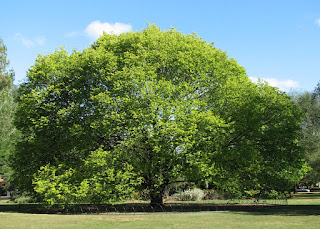Best Shade Trees
Large, deciduous shade trees can help keep your home and outdoor spaces cooler by blocking the hot sun. These trees also add beauty to your landscape with features such as flowers, pretty fall foliage, colors, and interesting bark.
Ginkgo
The extremely pest-resistant ginkgo has unique, fan-shape leaves that turn a buttery yellow in fall. It's best to buy only trees labeled as male, because female ginkgoes produce messy, stinky (but edible) fruit. Look for these top-performing ginkgo varieties: 'Autumn Gold'; 'Magyar'; Presidential Gold; Emperor; and 'Princeton Sentry'.
Name: Ginkgo biloba
Growing Conditions: Full sun in medium moisture, well-drained soil
Size: Up to 80 feet tall and 40 feet wide
Oak
Congress named the oak as America's national tree in 2004. More than 60 species of oak are native to the United States, so try to choose the best oak for your region. Live oak is the recommended oak species for Southern regions. In colder regions, northern red oak thrives the best. Burr oak, pin oak, sawtooth oak, scarlet oak, and swamp white oak are just some of the popular oak species with colorful fall foliage.
Name: Quercus spp.
Growing Conditions: Full sun in medium moisture, well-drained soil
Size: Up to 80 feet tall and wide (depending on variety)
American Hornbeam
Tough, low-maintenance shade trees that grow nearly anywhere, American hornbeams sport textured leaves that turn yellow to red in fall, then persist through winter. This shorter shade tree has beautiful ridged bark that's most noticeable in winter. This slow-growing, deciduous tree develops an attractive rounded shape.
Name: Carpinus caroliniana
Growing Conditions: Part shade to full shade in medium moisture soil
Size: Up to 35 feet tall and wide
Kentucky coffee tree
A tough shade tree that's resistant to insects and diseases, Kentucky coffee tree was named for its seeds, produced in long pods each year. Those seeds were ground, roasted, and used by early settlers as a coffee substitute. This tall, deciduous tree has scaly. gray-brown bark and yellow-to-brown fall foliage that will add bright color to your landscape. Look for standout male varieties (without seed pods, which can be messy) such as 'Espresso' and Prairie Titan.
Name: Gymnocladus dioicus
Growing Conditions: Full sun in moist, well-drained soil
Size: Up to 80 feet tall and 55 feet wide
American Linden
Slow-growing and stately, lindens come in a wide variety of types. Also known as American basswood, the heart-shape leaves provide dense shade, while the tiny yellow flowers produce small fruits that birds like. This medium to large deciduous tree produces a pale yellow fall color. Check out the following popular varieties: American Sentry (Tilia americana 'Mck Sentry'); 'Boulevard'; Legend (Tilia americana 'DTR 123'); 'Lincoln'; 'Redmond'; and Tilia americana var. heterophylla, known as white basswood or beetree linden.
Name: Tilia americana
Growing Conditions: Full sun to part shade in medium moisture, well-drained soil
Size: Up to 80 feet tall and 50 feet wide
Maple
One of the most dazzling shade trees for fall color is the maple. No matter what size yard you have, there's a colorful type of maple tree to fit your needs. In addition to their showy leaves, some types (such as the paperbark maple and coral bark Japanese maple) display intriguing branch color and texture. Other species, such as the red maple, display brightly colored flower clusters.
Name: Acer spp.
Growing Conditions: Full sun to part shade in medium to wet, well-drained soil
Size: Up to 70 feet tall and 50 feet wide
Tulip Tree
One of the largest trees native to North America, the tulip tree is named for its cup-shape orange, yellow, and green flowers that appear in late spring. The flowers are followed by dry, cone-shape brown fruits. Its bright green leaves turn golden yellow in fall. For a smaller cultivar, look for 'Little Volunteer' which grows up to 35 feet tall.
Name: Liriodendron tulipifera
Growing Conditions: Full sun in moist, well-drained soil.
Size: Up to 90 feet tall and 50 feet wide
Tupelo
Count on superb red fall color, plus shades of yellow, orange, and purple, when you plant a tupelo. This native tree is also commonly called black gum, sour gum, and black tupelo. Its dark green leaves turn bright scarlet in fall, and its fall fruits attract migrating songbirds.
Name: Nyssa sylvatica
Growing Conditions: Full sun to part shade in average, medium to wet soils
Size: Up to 50 feet tall and 30 feet wide
Japanease Zelkova
Noted for its graceful shape, clean foliage, and resistance to Dutch elm disease, Japanese zelkova is a large deciduous tree with an upward-branching, vase-shape crown. As the tree ages, its smooth gray bark peels to reveal orange-brown inner bark. In the fall, its leaves turn a beautiful yellow-orange to red-brown color. Improved cultivars include 'Green Vase', 'Halka', 'Musachino', and 'Village Green'.
Name: Zelkova serrata
Growing Conditions: Full sun in average, medium wet, well-drained soil
Size: Up to 80 feet tall and 80 feet wide
Elm
With its distinctive vase shape and strong branches, elms have long been popular shade trees. Dutch elm disease, however, killed millions of American elms in North America between 1930 to the late 1980s. Now, new disease-resistant varieties such as 'Princeton' are available. Lacebark or Chinese elms offer unusual mottled bark, small leaves, and good resistance to both Dutch elm disease and elm leaf beetle.
Name: Ulmus spp.
Growing Conditions: Full sun in medium moisture, well-drained soil
Size: Up to 60 feet tall and 40 feet wide













Comments
Post a Comment